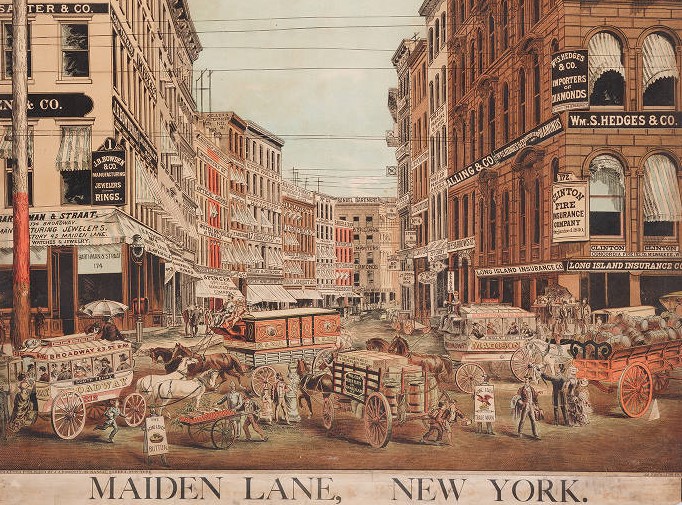History of New York's 47th Street Diamond District
1790s - 1920s
New York's Diamond District originated in about 1790, soon after the Revolutionary War, on Maiden Lane, which is located slightly north of Wall Street at the southern end of Manhattan. It was here that jewelers would gather each day to sell their wares to wealthy New Yorkers. The district grew modestly over the next hundred years then experienced a rapid expansion in 1900 following the completion of a ten story, fireproof office tower designed to accommodate the diamond trade. 14 Maiden Lane featured reinforced floors to support heavy vaults and large windows to provide abundant daylight favored by diamond dealers. Soon, over 300 jewelry firms crammed into a two block stretch along Maiden Lane.
1920s - 1940s
In the early 1920s, financial firms began moving to lower Manhattan. Soon, rents began to skyrocket and jewelers began to leave. Their next stop was Canal Street and the Bowery. This northern exodus took a brief sidestep after the 1929 market crash. When financial firms started to fold, lower-Manhattan rents sank allowing exiled diamond firms to detour to the newly-affordable office space on Fulton and Nassau Streets. By the time rents began rising again in the late 1930s, word was already spreading about a new, possibly permanent home for the diamond trade uptown on West 47th Street.
1940s – 1960s
Way back in 1923, sensing that Maiden Lane's diamond days were numbered, real estate broker Fenimore Goode began constructing buildings specifically designed for the diamond trade on West 47th Street between 5th and 6th Avenues. As jewelers and gem dealers slowly trickled uptown, events across the globe turned that trickle into a sudden torrent. Within several years, tens of thousands of European Jewish refugees streamed into New York to escape Nazi persecution. Among them were scores of successful and skilled diamond merchants and artisans, who, in rebuilding their lives, opened businesses in the 47th Street Diamond District to set the stage for a vast new industry along a single city block.
1960s - 2000s
Consolidating diamond cutting, jewelry manufacturing, and commercial and retail jewelry trade into a single concentrated district, soon led the way for the 47th Street Diamond District to become the central hub of the global diamond industry and the world’s premier shopping destination for gold and diamond jewelry.
21st Century and Beyond
Today, the 47th Street Diamond District boasts the largest concentration of diamond and jewelry related companies and retailers. An estimated 90% of diamonds in the United States pass through the 47th Street Diamond District. It is currently home to more than 2,600 businesses, employs 33,000 people, boasts an average of $400 million in daily transactions, and rings in approximately $24 billion in annual sales. When COVID-19 severely impacted the Diamond District's ability to operate during the early days of the pandemic, New York State recognized the district’s extraordinary role in the nation’s economy and cleared the Diamond District to re-open during the earliest stages of the recovery. As the second decade of the 21st century gets underway at last, the Diamond District continues to thrive as an iconic and unique part of the New York City experience. Busier than ever, safer than ever, the 47th Street Diamond District remains an economic powerhouse, representing the very best of New York now and well into the future.



